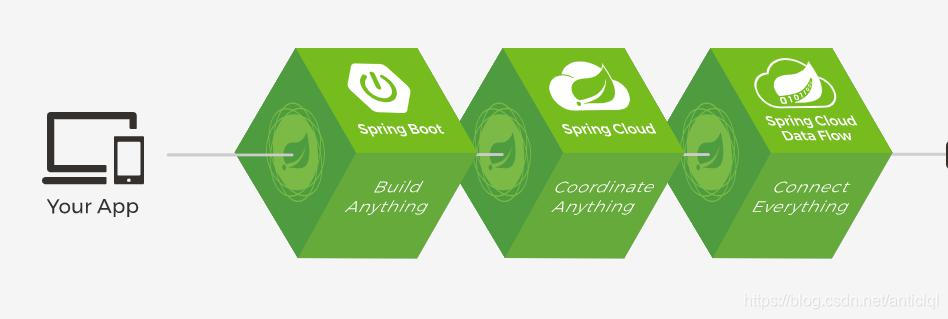1、Spring
1.1、简介
-
Spring:春天--------->>给软件行业带来了春天!
-
2002年,首次退出了Spring框架的雏形:interface21框架!
-
Spring框架于2004年3月24日正式发布1.0正式版。
-
Rod Johnson,Spring Framework创始人,著名作者。悉尼大学博士,但专业不是计算机,而是音乐学。
-
Spring理念:使现有的技术更加容易使用,本身是一个大杂烩,整合了现有的技术框架!
-
SSH:Struct2 + Spring + Hibernate
-
SSM:SpringMvc + Spring + Mybatis
如何下载Spring博客:https://blog.csdn.net/qingpengshan/article/details/79998970
官网:https://spring.io/projects/spring-framework#overview
官网下载地址:http://repo.spring.io/release/org/springframework/spring
GitHub: https://github.com/spring-projects/spring-framework
<!-- https://mvnrepository.com/artifact/org.springframework/spring-webmvc -->
<dependency>
<groupId>org.springframework</groupId>
<artifactId>spring-webmvc</artifactId>
<version>5.3.22</version>
</dependency>
<!-- https://mvnrepository.com/artifact/org.springframework/spring-webmvc -->
<dependency>
<groupId>org.springframework</groupId>
<artifactId>spring-jdbc</artifactId>
<version>5.3.22</version>
</dependency>
1.2、优点
-
Spring是一个开源的免费的框架(容器)!
-
Spring是一个轻量级的、非入侵式的框架!
-
控制反转(IOC),面向切面编程(AOP)
-
支持事务的处理,对框架整合的支持!
总结一句话:Spring就是一个轻量级的控制反转(IOC)和面向切面编程(AOP)的框架!
1.3、组成
[外链图片转存失败,源站可能有防盗链机制,建议将图片保存下来直接上传(img-9jv7ImIM-1662801861123)(C:\Users\user\AppData\Roaming\Typora\typora-user-images\image-20220904185102053.png)]
1.4、拓展
在Spring的官网有这个介绍:现代化的Java开发!说白就是基于Spring的开发!

-
Spring Boot
- 一个快速开发的脚手架。
- 基于SpringBoot可以快速的开发单个微服务。
- 约定大于配置!
-
Spring Cloud
- SpringCloud是基于SpringBoot实现的。
因为现在大多数公司都在使用SpringBoot进行快速开发,学习SpringBoot的前提,需要完全掌握Spring及SpringMVC!承上启下的作用!
弊端:发展了太久之后,违背了原来的理念!配置十分繁琐,人称:”配置地狱!“
2、IOC理论推导
-
UserDao接口
-
UserDaoImpl实现类
-
UserService业务接口
-
UserServiceImpl业务实现类
在我们之前的业务中,用户的需求可能会影响我们原来的代码,我们需要根据用户的需求去修改源代码!如果程序代码量十分大,修改一次的成本代价十分昂贵!
[外链图片转存失败,源站可能有防盗链机制,建议将图片保存下来直接上传(img-1ebdTQU8-1662801861126)(C:\Users\user\AppData\Roaming\Typora\typora-user-images\image-20220905100936310.png)]
我们使用一个set接口实现,已经发生了革命性的变化!
private UserDao userDao;
//利用set进行动态实现值的注入!
public void setUserDao(UserDao userDao) {
this.userDao = userDao;
}
- 之前,程序是主动创建对象!控制权在程序员手上!
- 使用了set注入后,程序不再具有主动性,而是变成了被动的接收对象!
这种思想,从本质上解决了问题,我们程序员不用再去管理对象的创建了。系统的耦合性大大降低,可以更加专注的在业务的实现上!这是IOC的原型!
[外链图片转存失败,源站可能有防盗链机制,建议将图片保存下来直接上传(img-gcMTv19m-1662801861127)(C:\Users\user\AppData\Roaming\Typora\typora-user-images\image-20220905101000034.png)]
**控制反转IOC( Inversion of Control),是一种设计思想,DI(依赖注入)是实现IOC的一种方法,**也有人认为DI只是IOC的另一种说法。没有IOC的程序中,我们使用面向对象编程,对象的创建与对象间的依赖关系完全硬编码在程序中,对象的创建由程序自己控制,控制反转后将对象的创建转移给第三方,个人认为所谓控制反转就是:获得依赖对象的方式反转了
控制反转是一种通过描述(XML或注解)并通过第三方去生产或获取特定对象的方式。在Spring中实现控制反转的是IoC容器,其实现方法是依赖注入( Dependency Injection,Dl)。
3、HelloSpring
UserDao
package com.hua.dao;
//接口
public interface UserDao {
void getUser();
}
UserDaoImpl
package com.hua.dao;
public class UserDaoImpl implements UserDao{
@Override
public void getUser() {
System.out.println("默认获取用户的数据");
}
}
UserDaoMysqlImpl
package com.hua.dao;
public class UserDaoMysqlImpl implements UserDao{
@Override
public void getUser() {
System.out.println("Mysql获取用户数据!");
}
}
UserDaoOracleImpl
package com.hua.dao;
public class UserDaoOracleImpl implements UserDao{
@Override
public void getUser() {
System.out.println("oracle获取数据!");
}
}
UserService
package com.hua.service;
public interface UserService {
void getUser();
}
UserServiceImpl
package com.hua.service;
import com.hua.dao.UserDao;
public class UserServiceImpl implements UserService{
// private UserDao userDao = new UserDaoMysqlImpl();
private UserDao userDao;
//利用set进行动态实现值的注入!
public void setUserDao(UserDao userDao) {
this.userDao = userDao;
}
@Override
public void getUser() {
userDao.getUser();
}
}
配置文件beans.xml如下
<?xml version="1.0" encoding="UTF-8"?>
<beans xmlns="http://www.springframework.org/schema/beans"
xmlns:xsi="http://www.w3.org/2001/XMLSchema-instance"
xsi:schemaLocation="http://www.springframework.org/schema/beans http://www.springframework.org/schema/beans/spring-beans.xsd">
<bean id="mysqlImpl" class="com.hua.dao.UserDaoMysqlImpl"></bean>
<bean id="oracleImpl" class="com.hua.dao.UserDaoOracleImpl"></bean>
<bean id="sqlService" class="com.hua.dao.UserDaoSqlServiceImpl"></bean>
<bean id="UserServiceImpl" class="com.hua.service.UserServiceImpl">
<!--ref:引用Spring容器中创建好的容器
value:具体的值,基本数据类型!
-->
<property name="userDao" ref="sqlService"></property>
</bean>
</beans>
编写测试类MyTest
import com.hua.service.UserServiceImpl;
import org.springframework.context.ApplicationContext;
import org.springframework.context.support.ClassPathXmlApplicationContext;
public class MyTest {
public static void main(String[] args) {
//用户实际调用的是业务层,dao层他们不需要接触!
//通过接口获取实现类,接口必须接收的是接口实现类
/*UserService userService = new UserServiceImpl();
((UserServiceImpl) userService).setUserDao(new UserDaoSqlServiceImpl());
userService.getUser();*/
//获取applicationContext;拿到spring容器
ApplicationContext applicationContext = new ClassPathXmlApplicationContext("beans.xml");
//容器在手,天下我又,需要什么,就直接get什么!
UserServiceImpl userServiceImpl = (UserServiceImpl) applicationContext.getBean("UserServiceImpl");
userServiceImpl.getUser();
}
}
思考:
-
Hello对象由谁创建?
hello对象由Spring创建
-
Hello对象的属性是怎么设置的?
hello对象的属性是由Spring容器设置的
这个过程就叫控制反转(IOC)
控制:谁来控制对象的创建,传统应用程序的对象是由程序本身控制创建的,使用 Spring后,对象是由 Spring来创建的
反转:程序本身不创建对象,而变成被动的接收对象
依赖注入:就是利用set方法来进行注入的
IOC: 是一种编程思想,由主动的编程变成被动的接收
可以通过 newClassPathXmlApplicationContext去测览一下底层源码
所谓的IOC,一句话搞定:对象由 Spring来创建,管理,装配!
4、IOC创建对象的方式
-
使用无参构造创建对象,默认!
-
假设我们要使用有参构造创建对象。
-
下标赋值
<!--1、下标赋值--> <bean id="user" class="com.hua.pojo.User"> <constructor-arg index="0" value="hua"/> </bean> -
类型
<!--2、通过类型创建,不建议使用--> <bean id="user" class="com.hua.pojo.User"> <constructor-arg type="java.lang.String" value="huahua"/> </bean> -
参数名
<!--3、直接通过参数名--> <bean id="user" class="com.hua.pojo.User"> <constructor-arg name="name" value="break"></constructor-arg> </bean>
-
总结:在配置文件加载的时候,容器中管理的对象就已经初始化了!
5、Spring配置
5.1、别名
<!--别名,如果添加了别名,我们也可以使用别名获取到这个对象-->
<alias name="user" alias="us"/>
5.2、Bean的配置
<!--
id : bean的唯一标识符,也就是相当于我们学的对象名
class : bean对象所对应的全限定名 :包名 + 类型
name : 也是别名,而且name可以同时取多个别名
-->
<bean id="userT" class="com.hua.pojo.User1" name="user2,u2">
<property name="name" value="花花"/>
</bean>
5.3、import
这个import,一般用于团队开发使用,他可以将多个配置文件,导入合并为一个。
假设,现在项目中有多个人开发,这三个负责不同的类开发,不同的类需要注册在不同的bean中,我们可以利用import将所有人的beans.xml合并为一个总的!
-
张三----->>beans1.xml
-
李四----->>beans2.xml
-
王五----->>beans3.xml
-
applicationContext.xml
<?xml version="1.0" encoding="UTF-8"?> <beans xmlns="http://www.springframework.org/schema/beans" xmlns:xsi="http://www.w3.org/2001/XMLSchema-instance" xsi:schemaLocation="http://www.springframework.org/schema/beans http://www.springframework.org/schema/beans/spring-beans.xsd"> <import resource="beans.xml"/> <import resource="beans2.xml"/> </beans>
使用的时候,自己使用总的配置就可以了
6、依赖注入(DI)
6.1、构造器注入
前面已经说过了
6.2、Set方式注入【重点】
- 依赖注入:Set注入!
- 依赖:bean对象的创建依赖于容器
- 注入:bean对象中的所有属性,由容器来注入!
【环境搭建】
- 复杂类型
- 真实测试对象
beans.xml
<?xml version="1.0" encoding="UTF-8"?>
<beans xmlns="http://www.springframework.org/schema/beans"
xmlns:xsi="http://www.w3.org/2001/XMLSchema-instance"
xsi:schemaLocation="http://www.springframework.org/schema/beans http://www.springframework.org/schema/beans/spring-beans.xsd">
<bean id="student" class="com.hua.pojo.Student">
<!--第一种,普通值注入,value-->
<property name="name" value="花花"/>
<!--第二种,Bean注入-->
<property name="address" ref="address"/>
<!--第三种,数组注入-->
<property name="book">
<array>
<value>红楼梦</value>
<value>西游记</value>
<value>水浒传</value>
<value>三国演义</value>
</array>
</property>
<!--第四种,List注入-->
<property name="hobbys">
<list>
<value>唱歌</value>
<value>跳舞</value>
<value>画画</value>
</list>
</property>
<!--第五种,map注入-->
<property name="card">
<map>
<entry key="身份证" value="23133342"/>
<entry key="校园卡" value="243894892839"/>
</map>
</property>
<!--第六种,Set注入-->
<property name="game">
<set>
<value>王者荣耀</value>
<value>开心消消乐</value>
</set>
</property>
<!--第七种,Null(空值)注入-->
<property name="wife">
<null/>
</property>
<!--第八种,Properties注入-->
<property name="info">
<props>
<prop key="学号">2020440223</prop>
<prop key="性别">女</prop>
</props>
</property>
</bean>
<bean id="address" class="com.hua.pojo.Address">
<property name="address" value="重庆"/>
</bean>
</beans>
6.3、拓展方式注入
我们可以使用p命名空间和c命名空间
<!--P命名空间注入,可以直接注入属性的值-->
<bean id="user" class="com.hua.pojo.User" p:name="小小" p:age="12"/>
<!--c命名空间注入,通过构造器注入:construct-args-->
<bean id="user2" class="com.hua.pojo.User" c:name="微微" c:age="18" scope="prototype"/>
测试
public static void main(String[] args) {
ApplicationContext applicationContext = new ClassPathXmlApplicationContext("UserBeans.xml");
User user =(User) applicationContext.getBean("user");
System.out.println(user.toString());
}
注意点:p命名和c命名空间不能直接使用,需要导入xml约束
xmlns:p="http://www.springframework.org/schema/p"
xmlns:c="http://www.springframework.org/schema/c"
6.4、bean的作用域
[外链图片转存失败,源站可能有防盗链机制,建议将图片保存下来直接上传(img-P81jA3JJ-1662801861129)(C:\Users\user\AppData\Roaming\Typora\typora-user-images\image-20220909080824945.png)]
1、Singleton Scope(单例模式)
Spring的默认机制
[外链图片转存失败,源站可能有防盗链机制,建议将图片保存下来直接上传(img-L8jMYHIr-1662801861130)(C:\Users\user\AppData\Roaming\Typora\typora-user-images\image-20220909080930947.png)]
<bean id="user2" class="com.hua.pojo.User" c:name="微微" c:age="18" scope="singleton"/>
2、Prototype Scope(原型模式)
每次从容器中get的时候,都会产生一个新的对象!
[外链图片转存失败,源站可能有防盗链机制,建议将图片保存下来直接上传(img-dVexHW4S-1662801861130)(C:\Users\user\AppData\Roaming\Typora\typora-user-images\image-20220909081155129.png)]
<bean id="user2" class="com.hua.pojo.User" c:name="微微" c:age="18" scope="prototype"/>
3、其余的request、session、application这些个只能在web开发中使用到!
7、Bean的自动转配
- 自动装配是Spring满足bean依赖的一种方式!
- Spring会在上下文中自动寻找,并自动给bean装配属性!
在Spring中有三种装配的方式
-
在xml中显示的配置
-
在java中显示配置
-
隐式的自动装配bean【重点】
7.1、测试
- 环境搭建
- 一个人有两个宠物!
7.2、byName自动装配
<bean id="cat" class="com.hua.pojo.Cat"/>
<bean id="dog2" class="com.hua.pojo.Dog"/>
<bean id="people" class="com.hua.pojo.People" autowire="byName"/>
7.3、byType自动装配
<bean id="cat" class="com.hua.pojo.Cat"/>
<bean id="dog2" class="com.hua.pojo.Dog"/>
<bean id="people" class="com.hua.pojo.People" autowire="byType"/>
<!--
byName: 会自动在容器上下文中查找,和自己对象set方法后面的值对应的bean id!
byType: 会自动在容器上下文中查找,和自己对象属性雷翔相同的bean!
-->
小结:
- byName的时候,需要保证所有的bean的id唯一,并且这个bean需要和自动注入的属性的set方法的值一致!
- byType的时候,需要保证所有的bean的class唯一,并且这个bean需要和自动注入的属性的类型一致!
7.4、使用注解实现自动装配
jdk1.5支持的注解,Spring2.5就支持注解了!
The introduction of annotation-based configuration raised the question of whether this approach is “better” than XML.
要使用注解须知:
-
导入约束:context约束
-
配置注解的支持 : context:annotation-config/ 【重要!】
<?xml version="1.0" encoding="UTF-8"?> <beans xmlns="http://www.springframework.org/schema/beans" xmlns:xsi="http://www.w3.org/2001/XMLSchema-instance" xmlns:context="http://www.springframework.org/schema/context" xsi:schemaLocation="http://www.springframework.org/schema/beans https://www.springframework.org/schema/beans/spring-beans.xsd http://www.springframework.org/schema/context https://www.springframework.org/schema/context/spring-context.xsd"> <context:annotation-config/> </beans>
@Autowired
直接在属性上使用即可!也可以在set方式上使用!
使用@Autowired我们可以不用编写Set方法了,前提是你这个自动装配的属性在IOC(spring)容器中存在且符合名字byname!
科普:
@Nullable 字段标记了这个注解,说明这个字段可以为null!
public @interface Autowired {
boolean required() default true;
}
//如果显示定义了Autowired的required属性为false。说明这个对象可以为null,否则不允许为空
@Autowired(required = false)
如果@Autowired自动装配的环境比较复杂,自动装配无法通过一个注解【@Autowired】完成的时候,我可以使用@Qualifier(value = “xxx”)去配合@Autowired的使用,指定一个唯一的bean对象注入!
public class People {
@Autowired
private Cat cat;
@Autowired
@Qualifier(value = "dog22")
private Dog dog;
private String name;
}
@Resource注解
public class People {
@Resource(name = "cat")
private Cat cat;
@Resource
private Dog dog;
private String name;
}
小结:
@Resource和 @Autowired的区别:
- 都是用来自动装配的,都可以放在属性字段上
- @Autowired通过byType的方式实现,而且必须要求这个对象存在!【常用】
- @Resource默认通过byname的方式实现,如果找不到名字,则通过byType方式实现!如果两个都找不到的情况,就报错!【常用】
- 执行顺序不同:@Autowired通过byType的方式实现。@Resource默认通过byname的方式实现
8、使用注解开发
在Spring4之后,要使用注解开发,必须要保证AOP的包导入了
[外链图片转存失败,源站可能有防盗链机制,建议将图片保存下来直接上传(img-SKe5j81d-1662801861131)(C:\Users\user\AppData\Roaming\Typora\typora-user-images\image-20220910150712052.png)]
在使用注解需要导入context约束,增加注解的支持
<?xml version="1.0" encoding="UTF-8"?>
<beans xmlns="http://www.springframework.org/schema/beans"
xmlns:xsi="http://www.w3.org/2001/XMLSchema-instance"
xmlns:context="http://www.springframework.org/schema/context"
xsi:schemaLocation="http://www.springframework.org/schema/beans
https://www.springframework.org/schema/beans/spring-beans.xsd
http://www.springframework.org/schema/context
https://www.springframework.org/schema/context/spring-context.xsd">
<context:annotation-config/>
</beans>
-
bean
-
属性如何注入
//等价于 <bean id="user" class="com.hua.pojo.User"/> //@Component 组件 @Component public class User { //相当于<property name="name" value="花花呀"/> @Value("花花呀") public String name; public void setName(String name) { this.name = name; } } -
衍生的注解
@Component有几个衍生注解,我们在web开发中,会按照MVC三层架构分层!
-
dao 【@Repository】
-
service 【@Service】
-
controller 【@Controller】
这四个注解功能都是一样的,都是代表将某个类注册到spring容器中,装配Bean
-
-
自动装配注解【前面见过】
- @Autowired:自动装配,通过类型,名字 如果Autowired不能唯一自动装配上属性,则需要通过@Qualifier(value = "xxx") - @Nullable 字段标记了这个注解,说明这个字段可以为null! - @Resource:自动转配通过名字,类型 -
作用域
@Component @Scope(value = "singleton") public class User { //相当于<property name="name" value="花花呀"/> @Value("花花呀") public String name; public void setName(String name) { this.name = name; } } -
小结
xml与注解:
- xml更加万能,适用于任何场合!维护简单,方便
- 注解不是自己的类,使用不了,维护相对复杂
xml与注解最佳实践:
-
xml用来管理bean;
-
注解只负责完成属性的注入。
-
我们在使用的过程中,只需要注意一个问题:必须要注解生效,就需要开启注解的支持
<!--指定要扫描的包,这个包下的注解就会生效--> <context:component-scan base-package="com.hua"/> <context:annotation-config/>
9、使用Java的方式配置Spring
我们现在要完全使用Spring的xml配置了,全权交给java来做!
JavaConfig是Spring的一个子项目,在Spring4之后,它成为了一个核心功能!
[外链图片转存失败,源站可能有防盗链机制,建议将图片保存下来直接上传(img-SvQXnFa8-1662801861132)(C:\Users\user\AppData\Roaming\Typora\typora-user-images\image-20220910155317307.png)]
配置类
package com.hua.Config;
import com.hua.pojo.User;
import org.springframework.context.annotation.Bean;
import org.springframework.context.annotation.ComponentScan;
import org.springframework.context.annotation.Configuration;
import org.springframework.context.annotation.Import;
@Configuration
//这个也会被Spring容器托管,注册到容器中,因为她本来就是一个@Component,
//@Configuration代表这是一个配置类,就和我们之前看得bean.xml是一样的
@ComponentScan("com.hua.pojo")
@Import(MyConfig2.class)
public class MyConfig {
//注册一个bean,就相当于我们之前写的一个bean标签
//这个方法的名字,就相当于bean标签中的id属性
//这个方法的返回值,就相当于bean标签中的class属性
@Bean
public User getUser(){
return new User();//就是返回要注入到Bean的对象!
}
}
package com.hua.pojo;
import org.springframework.beans.factory.annotation.Value;
import org.springframework.stereotype.Component;
//这里这个注解的意思,就是说明这个类被Spring接管了,注册到了容器中
@Component
public class User {
private String name;
public String getName() {
return name;
}
@Value("桉森屿夏") //属性注入值
public void setName(String name) {
this.name = name;
}
@Override
public String toString() {
return "User{" +
"name='" + name + '\'' +
'}';
}
}
测试类
public class MyTest {
@Test
public void test1(){
//如果完全使用了配置类方式去做,我们就只能通过AnnotationConfigApplicationContext 上下文来获取容器,通过配置类的class对象加载!
AnnotationConfigApplicationContext acac = new AnnotationConfigApplicationContext(MyConfig.class);
User getUser = acac.getBean("getUser", User.class);
System.out.println(getUser.getName());
}
}
这种存java的配置方式,在SpringBoot中随处可见!